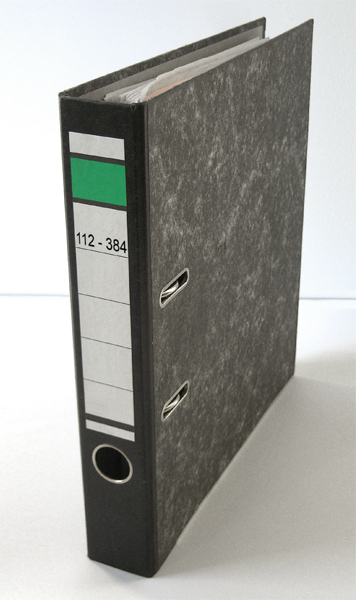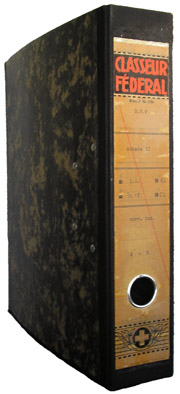Three-ring Binder on:
[Wikipedia]
[Google]
[Amazon]

 Ring binders (loose leaf binders, looseleaf binders, or sometimes called files in Britain) are large folders that contain file folders or hole punched papers. These binders come in various sizes and can accommodate an array of paper sizes. These are held in the binder by circular or D-shaped retainers, onto which the contents are threaded. The rings themselves come in a variety of sizes, including , though other sizes are also available. The rings are usually spring-loaded, but can also be secured by lever arch mechanisms or other securing systems. The binders themselves are typically made from plastic with metal rings. Early designs were patented during the early 1890s to the early 1900s.
Ring binders (loose leaf binders, looseleaf binders, or sometimes called files in Britain) are large folders that contain file folders or hole punched papers. These binders come in various sizes and can accommodate an array of paper sizes. These are held in the binder by circular or D-shaped retainers, onto which the contents are threaded. The rings themselves come in a variety of sizes, including , though other sizes are also available. The rings are usually spring-loaded, but can also be secured by lever arch mechanisms or other securing systems. The binders themselves are typically made from plastic with metal rings. Early designs were patented during the early 1890s to the early 1900s.
patent no. 23506
on April 5, 1859. German
patent no. 778070
on December 20, 1904 for a 3-ring binder that became a standard in the United States. The North American de facto standard spacing is between holes.
File:Ordner dicht en open.jpg, Two-ring binders, in open (right) and closed (left) positions
File:Three ring binder.JPG, Three-ring binder, open
File:Storex3RingBinder.jpg, Storex's three-ring binders, closed
File:Gaffelparm.jpg, Tengwall's four-ring "fork" binder, open

 Ring binders (loose leaf binders, looseleaf binders, or sometimes called files in Britain) are large folders that contain file folders or hole punched papers. These binders come in various sizes and can accommodate an array of paper sizes. These are held in the binder by circular or D-shaped retainers, onto which the contents are threaded. The rings themselves come in a variety of sizes, including , though other sizes are also available. The rings are usually spring-loaded, but can also be secured by lever arch mechanisms or other securing systems. The binders themselves are typically made from plastic with metal rings. Early designs were patented during the early 1890s to the early 1900s.
Ring binders (loose leaf binders, looseleaf binders, or sometimes called files in Britain) are large folders that contain file folders or hole punched papers. These binders come in various sizes and can accommodate an array of paper sizes. These are held in the binder by circular or D-shaped retainers, onto which the contents are threaded. The rings themselves come in a variety of sizes, including , though other sizes are also available. The rings are usually spring-loaded, but can also be secured by lever arch mechanisms or other securing systems. The binders themselves are typically made from plastic with metal rings. Early designs were patented during the early 1890s to the early 1900s.
History
AmericanHenry Tillinghast Sisson
Henry Tillinghast Sisson (August 20, 1831 – October 19, 1910) was a colonel in the Union Army during the American Civil War, a lieutenant governor of Rhode Island from 1875 to 1877 serving under Governor Henry Lippitt, and inventor of the thr ...
invented the three ring binder, receivinpatent no. 23506
on April 5, 1859. German
Friedrich Soennecken
Friedrich Soennecken (20 September 1848 – 2 July 1919) was an entrepreneur and inventor. He was the founder of Soennecken, a German office supplier.
Soennecken was born in Iserlohn-Dröschede, Sauerland in 1848, the son of a blacksmith. On ...
invented ring binders in 1886 in Bonn. He also registered a patent on November 14, 1886, for his ''Papierlocher für Sammelmappen'' ("paper hole maker for folders", or hole punch). German Louis Leitz
Louis Leitz (2 May 1846 – 18 May 1918) was a German inventor and founder of Esselte Leitz GmbH & Co KG, trained as a woodturner and also worked as a mechanic.
Biography
Leitz was born in Ingersheim. In 1896 he made some important changes in ...
, founder of Leitz, later made some important changes in development of ring binders in Stuttgart-Feuerbach
Feuerbach is a borough (''Stadtbezirk'') of the city of Stuttgart. Its name is derived from the small river of the same name that flows from the neighboring district of Botnang through Feuerbach. Feuerbach is home to one of Germany's biggest indu ...
. Leitz introduced the "finger hole" on the side of the binder to aid removal from crowded shelves, thereby creating the modern ring binder.
The ISO standard two holes are apart, according to ISO 838. The four-hole version has no ISO standard. The distances between holes are (3×8).
Another design for ring binders was invented in 1889 by Andreas Tengwall in Helsingborg, Sweden
Sweden, formally the Kingdom of Sweden,The United Nations Group of Experts on Geographical Names states that the country's formal name is the Kingdom of SwedenUNGEGN World Geographical Names, Sweden./ref> is a Nordic country located on ...
, and patented in 1890 under the name 'Trio binder', named after a business consortium of Tengwall and two associates. Tengwall's design uses four rings, in two paired sets. The hole placement of Tengwall's Trio binder is still used as a de facto standard for hole punching in Sweden under the name ''triohålning''. These holes are , , and apart.
William P. Pitt obtainepatent no. 778070
on December 20, 1904 for a 3-ring binder that became a standard in the United States. The North American de facto standard spacing is between holes.
Variations
Binders come in many standard sizes with respect to both capacity and paper size. Most countries use a two- or four-hole system for holding A4 sheets. The most common type in Canada and the United States is a three-ring system for letter size pages (); similar to the European standard A4 type paper. A standard sheet of paper has three holes with spacing of . "Ledger" size binders hold paper, and may use standard 3-ring spacing or multiple additional rings. The distance from the punched holes to the nearest edge of the paper is less critical, since small differences do not affect the compatibility of paper and binder. Typical distance from the paper edge to the center of the hole is , and typical diameter of the hole ranges from to in North American usage. More extensive coverage of official and de facto standards for punched holes can be found in the article Hole punch. Japan uses a unique system, referred to as J-Binder. This system is compatible with A4 and B5 paper with different products. The A4 version uses 30 closely spaced rings, while the B5 one uses 26. Less common variants such as a 20 ring A5 version also exist. Many personal organizers and memorandum books use a six- or seven-hole system, including Filofax andFranklinCovey
Franklin Covey Co., trading as FranklinCovey and based in Salt Lake City, Utah, is a coaching company which provides training and assessment services in the areas of leadership, individual effectiveness, and business execution for organizations a ...
. Most systems have the rings on the left side of the papers as one opens the binder, but there are also binders that have the rings (concealed by the binder cover) at the top edge of the paper, reminiscent of a clipboard.
There are also various options of binder types such as the commonly used vinyl binders or customizable poly binders, turned edge binders, and sewn binders.
Most binder covers are made of three pieces, in the fashion of a hardback book, with three pieces of board held together with sheets of vinyl or other materials and hinges. Materials vary widely. Some vinyl binders have a clear pocket on the outside for cover pages, and many have pockets in the inner cover for loose papers, business cards, compact discs, etc. There are also zipper binders, which zip the binder up and keep papers from falling out. Some binders are stored in matching slipcases for greater protection; either with one slipcase per each binder, or one slipcase holding several binders.
It is also possible to insert the sheet of paper into a polypropylene sheet protector. The sheet protector has pre-punched holes, so the document can be kept untouched and unwrinkled.
Gallery
See also
* Hole punch *Punched pocket
A punched pocket (UK English), plastic wallet (UK English), poly pocket (UK English), slippery fish (Sussex, England), sheet protector (US English), plastic sleeves (AU English), or sometimes perforated document bag, is a flat, slit plastic bag w ...
* Loose leaf
A loose leaf is a piece of paper of any kind that is not bound in place, or available on a continuous roll, and may be punched so as to be organized in a ring binder. Loose leaf paper may be sold as free sheets, or made up into notepads, where p ...
* Notebook
A notebook (also known as a notepad, writing pad, drawing pad, or legal pad) is a book or stack of paper pages that are often ruled and used for purposes such as note-taking, journaling or other writing, drawing, or scrapbooking.
History
...
* Springback binder
{{Unreferenced, date=February 2010
A springback binder with loose sheets
The sheets held together by the binder
Largest angle at which the binder can be opened without loosening the sheets
A springback binder is a device for rapid and repeated ...
*Card binder
Card binders and 9-pocket pages are devices used to protect trading cards or game cards (such as collectible card games) from damage and to store them. Card binders typically use a 3-ring binder or a D-ring binder.
9-pocket page
A 9-pocket page ...
References
External links
* {{DEFAULTSORT:Ring Binder German inventions 1886 introductions Notebooks Office equipment Stationery Swedish inventions